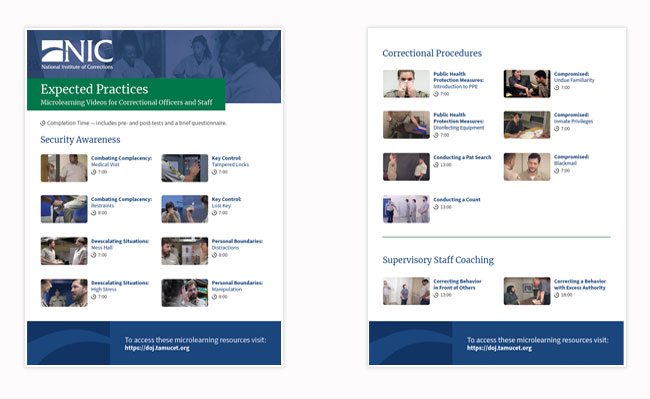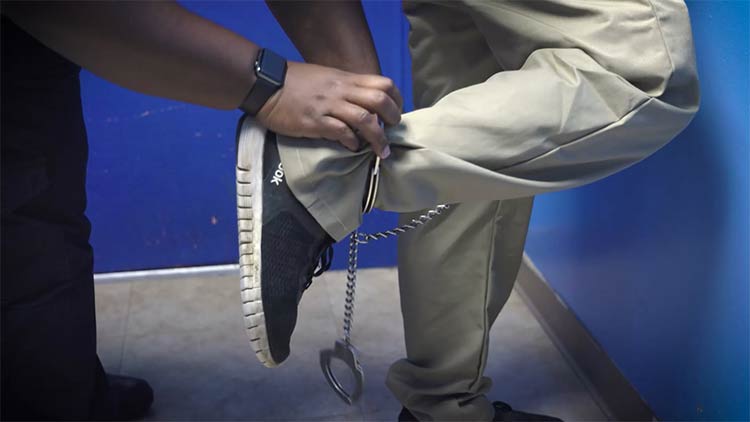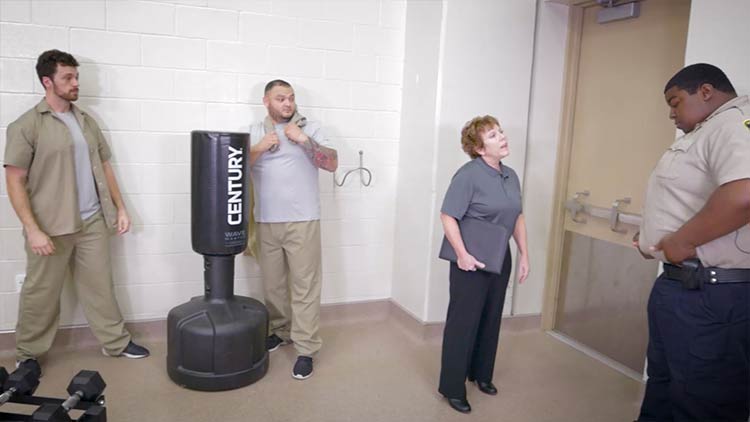Introduction
The Department of Justice (DOJ) and the National Institute of Corrections (NIC) recently conducted a pilot test to assess the effectiveness of a scenario-based microlearning program titled Expected Practices. This initiative aimed to support federal, state, local, and tribal correctional agencies by providing innovative training resources that reinforce essential correctional workforce duties. The pilot test, conducted in collaboration with Texas A&M University, evaluated the impact of microlearning on knowledge retention and skill development among correctional professionals.
The Need for the DOJ/NIC Project
Correctional officers face high-risk, high-stress environments where quick decision-making and adherence to best practices are critical for maintaining safety and security. Traditional training methods, such as classroom instruction and lengthy manuals, often fail to provide engaging, real-world scenarios that prepare officers for the unpredictable nature of their work. The DOJ/NIC project was developed to address this gap by offering short, interactive training modules that allow officers to practice decision-making in realistic, scenario-based environments. By integrating microlearning techniques, this project ensures that correctional staff can reinforce their skills efficiently and effectively, improving job performance and safer correctional facilities.

Pilot Test Overview
Correctional officers and educational technology developers at Texas A&M University designed the microlearning program. The training materials were structured into three key topics:
- Correctional Procedures
- Security Awareness
- Supervisory Staff
Each module included interactive videos and pre-and post-assessments to measure learning gains. The pilot test was conducted over two weeks, from October 28, 2024, to November 3, 2024, via a temporary website (doj.tamucet.org). Participants self-selected the training activities they wished to complete.

Module Format and Example Video
Each DOJ/NIC microlearning program module follows a structured format to maximize engagement and learning retention. A typical module consists of:
- Pre-Assessment: A short quiz to gauge the learner’s baseline knowledge.
- Interactive Video: A scenario-based video where learners make decisions at key points, influencing the outcome.
- Post-Assessment: A follow-up quiz to measure knowledge gains.
- Feedback & Reflection: Immediate feedback on choices made during the video, explaining the consequences of different decisions.
For example, the module Conducting a Count presents a realistic correctional facility scenario where an officer must decide how to handle a discrepancy in inmate count. The video includes clickable decision points, allowing the learner to choose between different responses. If the learner selects an incorrect action, the video rewinds and guides best practices, reinforcing proper procedures. This interactive, decision-based approach ensures that officers learn the correct protocols and understand the real-world consequences of their actions.
Key Findings from the Pilot Test
Correctional Procedures
- 28 learners participated in this section.
- The most completed activity was Introduction to PPE, with 18 learners finishing the module.
- Significant learning gains were observed in most activities, except for:
- Conducting a Pat Search: Pre-assessment mean of 75%, post-assessment mean of 95%. While the increase was educationally meaningful, statistical significance was not reached due to a small sample size (n=8).
- Disinfecting Equipment: No significant improvement, with both pre-and post-assessment scores averaging 60%. Further investigation is needed to determine the cause of stagnation.
- Compromised: Blackmail showed the most significant learning gains, but the post-assessment average of 48% suggests that learners did not achieve mastery, indicating a need for content refinement.


Security Awareness
- 17 learners participated in this section.
- The most completed activity was Complacency: Medical Visit, with 10 learners finishing the module.
- Complacency: Medical Visits showed a statistically significant increase in knowledge, with pre-assessment scores averaging 83.33% and post-assessment scores rising to 96.67%.
- Other activities, such as De-Escalating Situations: High Stress and Mess Hall Incidents, showed improvement but did not reach statistical significance, likely due to small sample sizes.
- Some activities, like Key Control: Lost Key and Personal Boundaries: Distractions, resulted in perfect scores at both pre-and post-assessment stages, suggesting that participants already had mastery of these topics.


Supervisory Staff
- 5 learners participated in this section.
- Only two learners completed both activities in this category.
- Correcting a Behavior with Excessive Authority showed a substantial improvement, with post-assessment scores reaching 100%. However, due to the small sample size, statistical significance could not be determined.
- Correcting Behavior in Front of Others showed no score change, indicating that the training did not significantly impact learning outcomes.


Challenges and Recommendations
Challenges
- Limited Sample Size: Many activities had too few participants to achieve statistical significance.
- Content Refinement Needed: Some modules, such as Disinfecting Equipment and Introduction to PPE, showed little to no improvement, indicating a need for content revision.
- Logistical Barriers: Filming in correctional facilities required extensive coordination, and additional time for production would have been beneficial.
Recommendations
- Expand Participant Pool: Future iterations should aim for at least 100 learners per activity to ensure reliable data.
- Refine Underperforming Modules: Subject matter experts should review and revise activities that did not yield significant learning gains.
- Enhance Promotion and Engagement: Encouraging more correctional staff to participate will improve the program’s effectiveness.
- Improve Assessment Alignment: Ensuring that assessment questions accurately reflect the learning objectives will enhance the validity of results.
Conclusion
The DOJ/NIC pilot test demonstrated positive trends in learner comprehension, with several activities showing significant learning gains. However, some modules require further refinement to maximize their impact. This microlearning initiative can become a valuable training resource for correctional professionals nationwide by addressing these challenges and implementing the recommended improvements.
As NIC proceeds to host these materials on their website, continued evaluation and iteration will be essential to ensuring that correctional staff receive the most effective and engaging training possible.